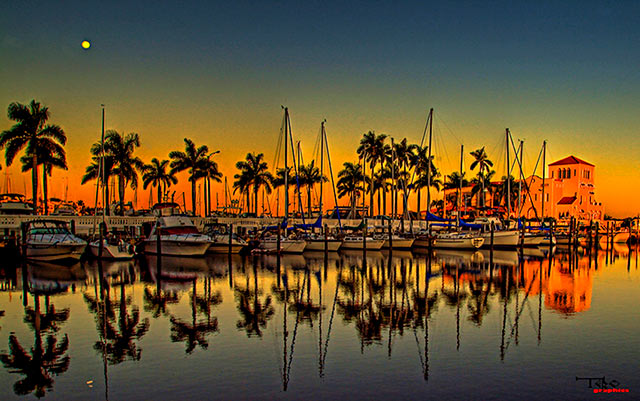Modern photography, with its array of software programs, allows a photographer to enhance their images and make them come alive with greater luminosity and color. They can be fun to make and give you the creative control to allow you to depict your artistic view of a scene.
Along with the wonderful use of the compositional elements of design, Chris developed an HDR (High Dynamic Range) image utilizing bracketing, a couple of specialized software programs and his creative vision.
Dawn Over the Pierby Chris Thibaut

Subject: Pier in early morning light at Twin Dolphin Marina, Bradenton, Florida
Conditions: “This is a HDR image made with three exposures in Photomatix, tweaked in Photoshop and Topaz Adjust.”
Composition:
1. Sense of serenity
2. Lines – both horizontal and vertical make strong triangle
3. Reflections
4. Color
5. HDR
Noella’s Comments:
The sense of calm and quiet in this image is superb. The day is almost starting and there is no movement or disturbance to the calm. This quietness is emphasized by a very strong horizon line splitting the image in two and then duplicating with precision the boats, masts and building in the strong reflections.
The repetitive shapes of the boats, masts and trees are vertical lines that tie the two parts together allowing the reality of the subject and its reflections to unite. Your eye has no place to wander except up and down the dock. They form a strong triangle that ends with the eye-stopping building on the far right.
Reflections can be a masterful addition to an image. They add to the sense of calm and they mirror the scene giving the objects, as well as the reflection of the objects, a collective impact. When photographing reflections it is important not to cut them off. A general rule of thumb that I use is… If you are showing the whole object and it is realistic, then let the entire reflection show. If it is making an abstract design, then crop it as suits the composition.
The color is important here as well. Chris, through his creative interpretation and use of HDR, intensified the colors. There is a purity of color in the primary complimentary colors of the blue sky and orange building. The orange light of the sky pulls your attention along the dock and centers itself in the large building. Both the color and size of the building creates a strong focal point and act as a “stop” to keep your eye from moving out of the image.
There are many ways to use your camera for artistic expression and one of the ways that has become very popular in recent years is the development of HDR or High Dynamic Range imagery. The purpose of doing an HDR image is to spread your exposure. You want to see the details in both the light areas and the dark areas of the image.
To simplify this, it is accomplished by bracketing – making at least three exposures (a normal exposure, one that is underexposed and one that is overexposed) and merging them together within an HDR software program. In Chris’s photograph, for example notice the light areas have detail in the hulls of the boats. There is also detail in the dark shadow areas of the palm fronds. All of this works to make a pleasant image out of one that would have been only silhouettes and shadows.
Very nice job on this image Chris and thanks for giving us a chance to introduce more photographers to HDR.
To learn more about HDR visit these articles:
What HDR Photography Really Stands For: How to Depict Reality
How to Make High Dynamic Range Photographs: Step-by-Step Lesson for Photo Imaging Technique
HDR Photography: Tone-mapping
Introduction to the HDR Zone System

Leave a Reply